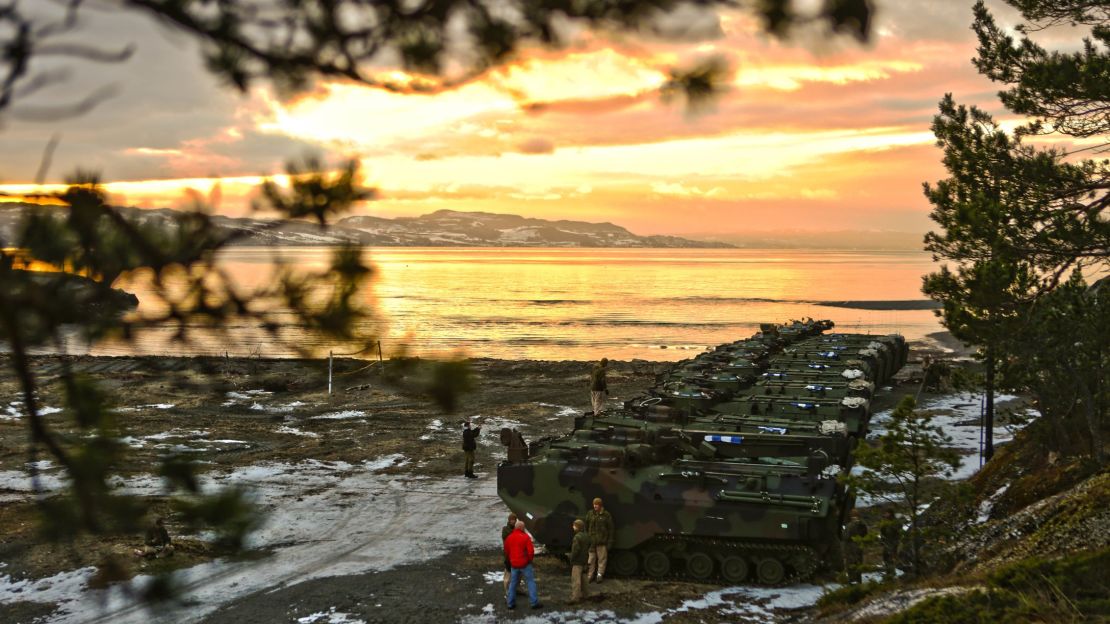Story highlights
The deployment of new equipment to the Cold War-era caves comes amid renewed tensions between NATO and Russia
The secured cave complex is a modern and robust facility, staffed by about 100 Norwegian and U.S. personnel
Marines are prepositioning battle tanks, artillery and logistics equipment inside Norwegian caves as the U.S. pushes to station equipment near the NATO-Russia frontier.
“Any gear that is forward-deployed both reduces cost and speeds up our ability to support operations in crisis, so we’re able to fall in on gear that is ready-to-go and respond to whatever that crisis may be,” Col. William Bentley, operations officer for the 2nd Marine Expeditionary Brigade, said in a statement Friday on the Norwegian deployment that called the caves classified.
The deployment of new equipment to the Cold War-era caves comes amid renewed tensions between NATO and Russia. Russia shares a 121.6-mile long border with Norway. The border was heavily militarized during the Cold War, and the Russian navy’s Northern Fleet is in Murmansk, about 100 miles from the border.
In October, Norway’s Chief of Defense, Adm. Haakon Bruun-Hanssen, told reporters that Russia has “shown that they are willing to use military force to achieve political ambitions.”

The climate-controlled caves are located throughout central Norway. The storage of American equipment there first began in 1981 during the Cold War in an effort to bolster NATO’s defenses against the Soviet Union, according to the Marines statement.
After the end of the Cold War, the United States questioned the rationale behind maintaining the cave complex, according to Magnus Nordenman, director of the Transatlantic Security Initiative at the Atlantic Council.
In a bid to save the cave facilities, the Norwegian government agreed to shoulder the cost of maintaining the caves during the 1990s, according to Nordenman, who has discussed the caves with the Norwegian Ministry of Defense.
The secured cave complex is a modern and robust facility, staffed by about 100 Norwegian and U.S. personnel, and it contains enough equipment to support 15,000 Marines, according to Nordenman. The equipment in the caves has been used to support operations in Iraq.
In bid to counter Putin, Obama seeks to quadruple military spending in Europe
Heather Conley, director of the Center for Strategic and International Studies’ Europe Program, told CNN that changes in the geopolitical landscape had once again made the caves a strategic asset.
“Now that we have a very new security context with Russia, it now makes sense to rethink what is needed,” she said.
Some 6,500 pieces of the equipment in the cave will be used in an upcoming training exercise, Cold Response 16, which will take place later this month, the Marines said. The exercise will include 12 NATO allies and partners and more than 16,000 troops.
The spokesman for the Norwegian Ministry of Defense told CNN that the goal of the exercise was to develop military capabilities “in a challenging environment” and that it would help “maintain credibility of NATO collective defense and deterrence capacity.”
Conley said the new military exercises were critical to ensuring that NATO could test its equipment and personnel in cold weather environments. Russia’s Northern Fleet conducted unannounced military drills in March involving 38,000 troops.
The announcement comes just days after the Department of Defense announced it was spending $3.4 billion for the European Reassurance Initiative in an effort to deter Russian aggression against NATO allies.
The initiative will include the prepositioning of equipment in the Baltic States, Poland and Central Europe.
The United States also announced Sunday that the U.S. Air Force will send six F-15s to Norway’s neighbor, Finland, this spring for exercises that will operate out of a base about 100 miles from the border with Russia.
Speaking on the new NATO-Russia dynamic, Conley said, “We have to look at Northern Europe, the Northern Atlantic, the Baltics and Eastern Europe as one theater of operations.”






















